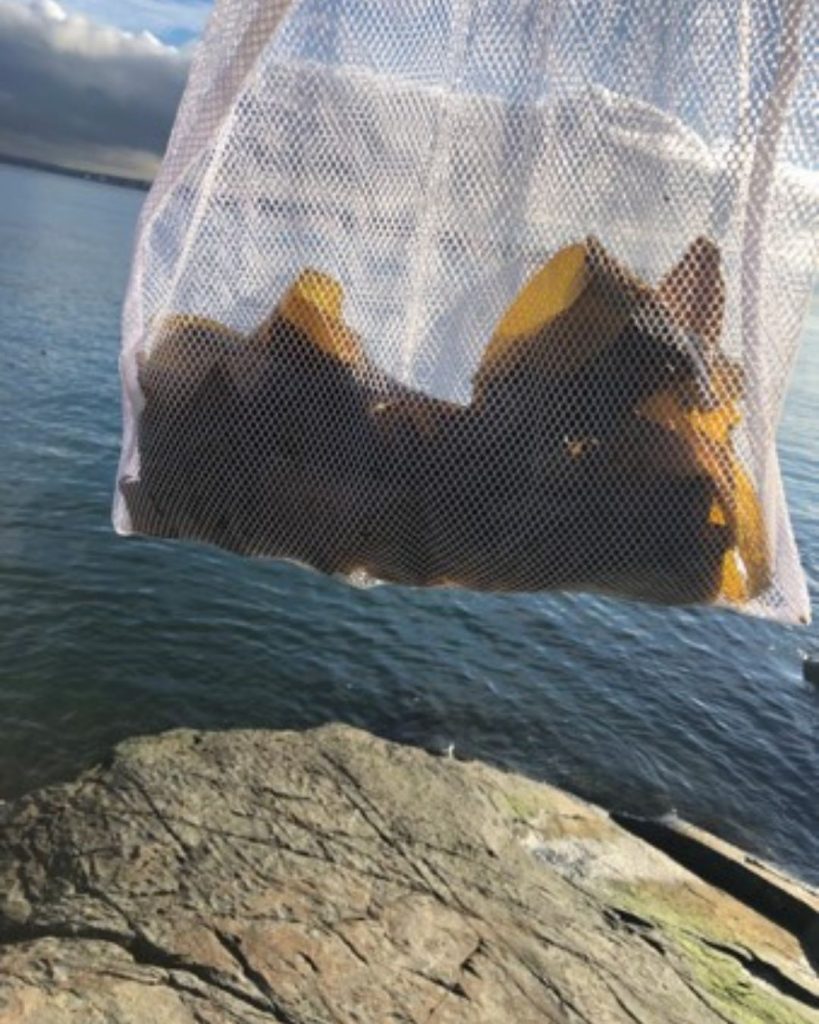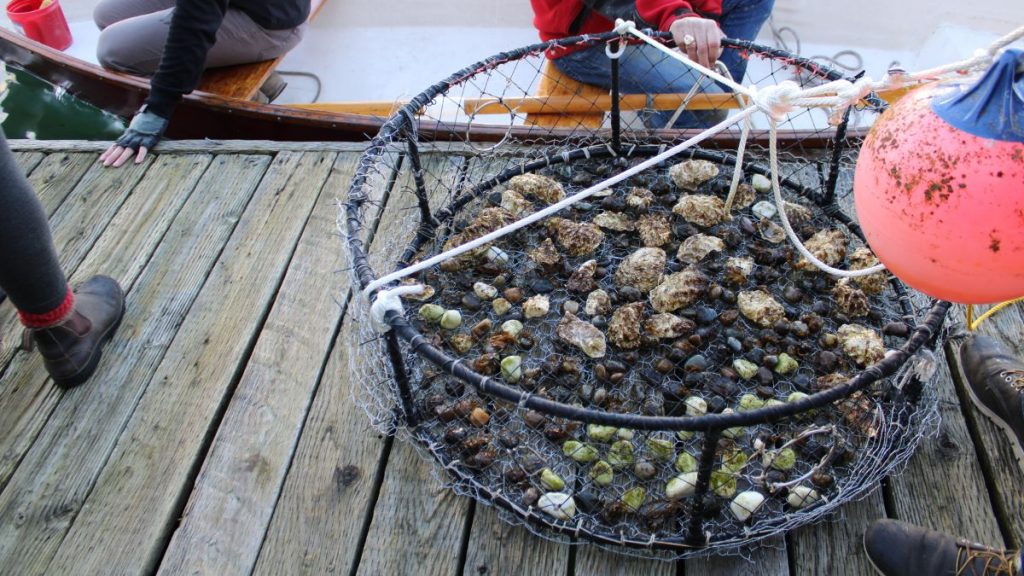
De la spore au sporophyte : Une année complète de culture du varech
By Max Wolf, Ocean Wise Seaforestation Coordinator
Kelp forests have been called the lungs of the ocean, thanks to their ability to sequester carbon and produce oxygen. But they’re so much more!
These underwater seascapes support an astonishing array of life, from tiny invertebrates to marine mammals. Providing critical food, shelter, and breeding grounds for thousands of ocean species including salmon, herring, sea otters and even orcas, kelp is foundational for life under the sea.
Unfortunately, kelp forests are currently in danger. Over the last 50 years, kelp forests around the world have declined at a significant rate due to climate change, biodiversity imbalances, and ocean pollution. And with half of existing kelp forests being degraded or damaged, the need for restoration has never been more pressing.
Ocean conservation has existed for decades, but kelp restoration is a relatively new frontier. There’s so much to discover when it comes to restoring kelp, but few have had the opportunity to unearth these insights. Which is where Ocean Wise comes in!
To accelerate global restoration efforts and fill knowledge gaps, we opened the Ocean Wise Kelp Nursery at the Pacific Science Enterprise Centre (PSEC) in West Vancouver in April 2023. Our nursery is an important research and development hub for developing and trialing novel kelp seed production methods as well as new and improved techniques for restoration.
After dedicating the spring and summer of 2023 to perfecting our set up, we embarked on our first full year of growing kelp from seed to sporophyte!
Fall 2023– Kelp Collection & Cultivation
To grow kelp in a lab, two things are absolutely necessary:
- Sorus Tissue: As the reproductive part of kelp, sorus tissue produces the spores that eventually grow into adult kelp. We opted to use sorus tissue from sugar kelp because herring love to lay their row on sugar kelp and supporting the local herring population was a key priority for our restoration partners.
- Substrates: Kelp needs a surface to grow on, but it won’t grow on just anything. We used the ‘green gravel’ method, which has kelp growing on movable elements like gravel and rocks, and (a North American first!) oyster shells.
In November, we put on our wetsuits and snorkeled around Stanley Park to collect sugar kelp sorus tissue. Once enough was gathered, we carefully transported the tissue to our Kelp Nursery where the best samples were isolated and stored in the fridge overnight to accelerate spore release.


When kelp dries out, whether naturally on the shore or after spending a night in the fridge, it experiences stress due to the unfavorable conditions. This might sound like a bad thing, but the stress is essential for encouraging the sorus tissue to release spores upon rehydration.
The next day, we transferred the dried out sorus pieces to sterile sea water to stimulate spore release. You’ll know you’ve successfully released millions of spores when the mixture, which we affectionately refer to as ‘kelp soup,’ turns murky brown in a matter of minutes.
Finally, after carefully laying out the gravel and oyster shells into sterile tanks, the ‘kelp soup’ was poured onto the substrates for the growing process to begin!


When kelp spores first settle on their substrates, there can be hundreds of thousands of spores but, as they grow and take up more space, the population thins itself. Going from thousands, to hundreds, and eventually –when individual kelps reach a centimeter in length– to a handful. This process occurs naturally and ensures that the strongest, best adapted, kelp survive!
During the early stages of growth, kelp seeds are microscopic, sensitive to environmental changes, and easily outcompeted. And it turns out, when you create ideal growing conditions for kelp, you also provide the perfect environment for its competitor – microalgae. Sugar kelp may be one of the fastest growing species on the planet, but microalgae grow even faster.
Contamination remained a challenge throughout the kelp’s time in the nursery. Whoever said marine biology is mostly cleaning was spot on, as we spent hours keeping the tanks clean and adjusting for light, aeration, and nutrients. But fortunately, kelp is increasingly resilient as it grows, becoming more and more able to withstand contamination every single day.
Once the kelp was finally visible to the naked eye, we breathed a sigh of relief. It was officially considered adult kelp (or sporophytes) and ready to be planted!


Winter 2024 – False Creek Harbour Outplanting
Winter is the perfect time to plant kelp, as kelp grows better in colder water. So, in early February, we packed up the sugar kelp and carefully transported it from West Vancouver to the False Creek Harbour at Granville Island for its first trial run in the ocean!
Our goal was to give the kelp more time to grow, without the risk of predation from urchins on the seafloor or lack of sunlight.
We arranged the oyster shells and green gravel in modified crab traps. These traps were then suspended in the water on ropes for easy monitoring and retrieval.

While this is an unconventional approach, this method proved to be extremely effective. After only two months, the sporophytes grew significantly with some reaching seven feet in length!

Spring 2024 – Open Ocean Outplanting
Once it was clear the kelp was loving life in the ocean, we invited our partner Biotherm, to help us plant the kelp in the open ocean in May.
Biotherm brought along 10 content creators to take part in the experience and together we relocated the sugar kelp to a kelp bed site in the Burrard Inlet.
We were thrilled with the success of the operation and the high overall survival rate. Ongoing monitoring is taking place to assess the continued success of this restoration project.


Summer/Fall 2024 – What’s Next!
Overall, our first year of growing and planting kelp was an excellent learning experience. Some of our favourite takeaways from the 2023/2024 season include:
- Oyster shells as substrates: The oyster shell experiment was interesting, and we were pleased to replicate this process that we observed while snorkelling, but the oyster shells were actually a bit too light and didn’t provide the weight we needed to keep the kelp at the restoration site.
- Timelines are more flexible than we thought: We went into the season under the impression that there were very strict rules for how long kelp could stay in the nursery and remain viable. Our kelp ended up staying in the nursery much longer than expected, but still thrived when relocated to the ocean.
- Every failure is an opportunity to learn: While we’re ending the season with a batch of kelp happily growing off the coast of B.C., our first round of kelp in the nursery didn’t survive. Knowing how to accept that, reflect on what needed the change, and try again was key to our success.
Now you might be wondering, what’s next?! First and foremost, we’re excited to start sharing what we’ve learned with the wider kelp restoration community. Kelp forest restoration is a new space with many unanswered questions. To effectively address these challenges, we must keep the collaborative momentum strong.
We’re currently working on “A guidebook to Quantifying Biodiversity, Ecosystem Health, and Ecosystem Benefits” with the Kelp Forest Alliance, coming this fall! This guidebook will help kelp rescuers all around the world monitor the health of kelp forests and restoration project in a standardized way.
Works are underway to quadruple our nursery’s capacity for the 2024/2025 season to improve our efficiency and grow even more sporophytes! This will allow us to scale our impact and perfect our methodology so that it can be replicated by other kelp conservationists.
We need the ocean, and the ocean needs the amazing kelp forests that foster beautiful and diverse ecosystems. A huge thanks to RBC for supporting the Ocean Wise Seaforestation initiative to make this work possible.
Posted August 22, 2024 by Kim Bricker









